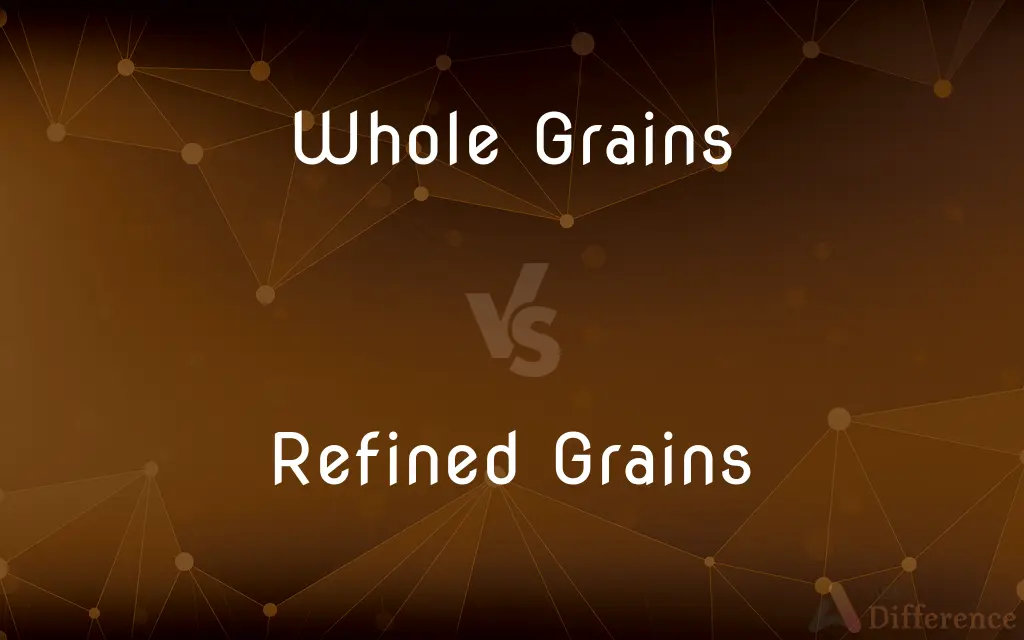Whole Grains vs. Refined Grains — What's the Difference?
Edited by Tayyaba Rehman — By Fiza Rafique — Published on December 3, 2023
Whole grains contain all parts of the grain; refined grains have parts removed.

Difference Between Whole Grains and Refined Grains
Table of Contents
ADVERTISEMENT
Key Differences
Whole grains are grains that have all of their parts — the bran, germ, and endosperm — intact. They are considered nutritionally superior because they contain essential nutrients and fiber. Refined grains, on the other hand, have had the bran and germ removed during processing, leaving only the endosperm.
The process that whole grains undergo keeps them rich in vitamins, minerals, and fiber. Consuming them can offer numerous health benefits such as reduced risk of chronic diseases. Refined grains, having lost some of their natural nutrients, often need to be "enriched" with vitamins and minerals to replace what was lost during refinement.
When it comes to digestion, whole grains tend to be digested slower than refined grains, providing a steady release of energy. This can be beneficial for blood sugar control. Refined grains, lacking in fiber, can lead to rapid spikes and drops in blood sugar levels.
Whole grains like quinoa, brown rice, and whole wheat bread can be easily incorporated into a balanced diet. Refined grains include products like white bread, white rice, and many pastries, which may lack some essential nutrients present in their whole counterparts.
In terms of taste and texture, whole grains might be denser and have a nuttier flavor compared to refined grains. The latter often have a softer texture and milder taste, which is why they're commonly preferred in many commercial foods.
ADVERTISEMENT
Comparison Chart
Nutritional Components
Contains bran, germ, endosperm
Only endosperm remains
Fiber Content
Higher fiber content
Lower fiber content
Digestion
Slower, steady energy release
Faster, can spike blood sugar
Common Examples
Brown rice, quinoa
White bread, white rice
Taste & Texture
Denser, nuttier flavor
Softer, milder flavor
Compare with Definitions
Whole Grains
The complete grain, offering more health benefits.
Oatmeal made from whole grains is a wholesome breakfast choice.
Refined Grains
Grains with bran and germ removed.
White bread is made from refined grains.
Whole Grains
Grains retaining bran, germ, and endosperm.
Brown rice is a popular type of whole grain.
Refined Grains
Grains that have been altered from their natural state.
Pastries often use refined grains for a softer texture.
Whole Grains
Natural grains without parts removed.
Quinoa is a versatile whole grain used in various dishes.
Refined Grains
Grains stripped of certain nutritional components.
Refined grain cereals may lack the fiber content of whole grain versions.
Whole Grains
Unprocessed grains with all nutritional components.
Whole grain bread offers more fiber than its refined counterpart.
Refined Grains
Processed grains lacking some natural nutrients.
Refined grains like white rice are staples in many dishes.
Whole Grains
Grains that haven’t been stripped of their nutritional elements.
Whole grain pasta is a healthier alternative to regular pasta.
Refined Grains
Often "enriched" grains to replace lost nutrients.
Some refined grain products are fortified with vitamins.
Common Curiosities
What are Whole Grains?
Grains that have all parts (bran, germ, and endosperm) intact.
What are Refined Grains?
Grains that have had the bran and germ removed, leaving only the endosperm.
Are Whole Grains healthier than Refined Grains?
Generally, yes, because whole grains retain more nutrients and fiber.
Do Whole Grains have a different taste than Refined Grains?
Yes, whole grains often have a denser, nuttier flavor.
Which digests slower, Whole Grains or Refined Grains?
Whole grains tend to digest slower due to higher fiber content.
Do Whole Grains have more calories than Refined Grains?
Not necessarily, but they typically offer more nutrients per calorie.
Why are Refined Grains more common in commercial foods?
They often have a longer shelf life and are preferred for their softer texture and milder taste.
Why are Refined Grains often "enriched"?
To replace some of the nutrients lost during the refinement process.
Are there benefits to eating Refined Grains?
They often have a softer texture and milder taste, but may lack some health benefits of whole grains.
How can I identify Whole Grains in products?
Look for terms like "whole grain" or "100% whole wheat" on packaging.
Do Refined Grains contribute to blood sugar spikes?
They can, due to faster digestion and lower fiber content.
Can I replace Refined Grains with Whole Grains in recipes?
Yes, though it may alter the texture and flavor of the dish.
What's an example of a Whole Grain?
Brown rice or quinoa are common examples.
Are there any health risks to consuming too many Refined Grains?
Excessive consumption can lead to nutrient deficiencies and increased risk of chronic diseases.
What's a common Refined Grain product?
White bread or white rice.
Share Your Discovery

Previous Comparison
Decadent vs. Degenerate
Next Comparison
Paternal Uncle vs. UncleAuthor Spotlight
Written by
Fiza RafiqueFiza Rafique is a skilled content writer at AskDifference.com, where she meticulously refines and enhances written pieces. Drawing from her vast editorial expertise, Fiza ensures clarity, accuracy, and precision in every article. Passionate about language, she continually seeks to elevate the quality of content for readers worldwide.
Edited by
Tayyaba RehmanTayyaba Rehman is a distinguished writer, currently serving as a primary contributor to askdifference.com. As a researcher in semantics and etymology, Tayyaba's passion for the complexity of languages and their distinctions has found a perfect home on the platform. Tayyaba delves into the intricacies of language, distinguishing between commonly confused words and phrases, thereby providing clarity for readers worldwide.












































